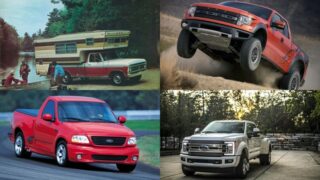Turbos And Carburators
Turbo’s and carburetors
There are 2 ways in which a turbo can be set up with a turbocharger.
Draw through and Blow through.
With both set ups, the normal sized carb should be suitable.
Draw through
Far and away the easist of the 2 to set up, however there can be issues with it, and its performance isn’t as great.
It, as the name suggests, draw air through the carburetor, to the turbo, which then compresses the air/fuel mixture.
Cars, such as the Corvair and the turbo Trans Am had such a system.
Benefits –
You don’t need any form of adjustment for the carburetor to adjust fuel flow – as the carburetor is on the "atmosphere" side of the turbo, and therefore the pressure it sees is the same, therefore it is much easier to set up.
Detractors –
Poorer performance – The turbo now has to draw a much heavier fuel/air mixture, and therefore it isn’t as efficient. Since fuel is much denser than air, it can seperate in the turbo, and pool, creating some turbo lag. The turbo can’t be posistioned right on the exhaust side, and it requires longer headers – which will cause further turbo lag.
Also, given you are drawing air through the carburettor – which drops pressure, and then you are increasing the pressure with a turbo, means further inefficiency as you are compressing air from a lower pressure, and it will also increase your intake temp – and you can’t run an intercooler (running fuel/air through one can be VERY dangerous (the fuel can condense inside the intercooler core and stay there if you then have an engine backfire the intercooler can explode), likewise a blow off valve shouldn’t be used (it would eject a fuel/air mixture into the engine bay). Water Injection is the only way of cooling your intake charge.
If you are building the engine in the backyard cheaply, this most likely would be the preffered way to go, as long as you can live with the turbo lag, and don’t want to run obscene boost pressures.
Blow through
More complex than the draw through arangement, but if set up correctly, has much improved performance.
It, as the name suggests again, means that the turbo is mounted before the carburetor, and it blows air through it.
To my knowledge this system has never been fitted to a production vehicle.
Benefits
Pretty much all of the detractors for the draw through set up are now reversed. You can use a blow off valve, an intercooler, turbo can be mounted on a set of real short exhaust headers, you aren’t drawing air at a lower pressure etc.
Detractors
It is (as I mentioned previously) more difficult to set up. You have two major dilema’s:
1. A carburetor can monitor air speed, and adjust fuel flow accordingly, but it can’t measure an increase in pressure. Therefore, you may have a system making 15psi, and sending double the amount of air that a N/A engine would recieve, but the carburetor would only provide fuel for the N/A engine, meaning it will run super lean. As turbo’s boost isn’t linear, it can make it hard to tune.
2. You will now have a positive pressure, and it can cause headaches with your fuel flowing through your jets. The pressure will try to crush the fuel float, it’s going to want to blow fuel mix out the throttle shaft, or back into the fuel line.
Also the carb must be sealed so it does not leak the pressurised air-fuel mix – it would be extremely dangerous. The best method I have heard of is placing the carb in an air tight box, and running a sealed throttle cable.
Because as the turbo increases boost that is more boost that the fuel pump must be able to overcome if it wants to push fuel into the carb. What you want is an electric fuel pump and a boost sensing fuel pressure regulator to increase fuel pressure as turbo boost pressure increases.
Fuel floats should be filled with something so they don’t get crushed under the pressure.
For the black art of fuel enrichment (to adjust for the higher pressures that the carb can’t monitor) I have heard some people overcome the first issue by just jetting the carburetor for when it is at maximum boost, however, when the turbo isn’t at maximum boost (the majority or the time for a street driven vehicle) it will run horribly rich, and isn’t really a suitible solution.
Another, better method is to have 4bbl carbs, the secondaries are jetted for the higher air pressures, and are operated by a vaccum system to open under sufficient turbo boost.
There are other more advanced methods, but if you want to attempt them, you (in my opinion) might as well run a basic EFI system, as most of them just attempt to mimic an EFI system.
So, what have you learnt after all this. Run EFI!!!
———————————-
By FTE’s BigF350




